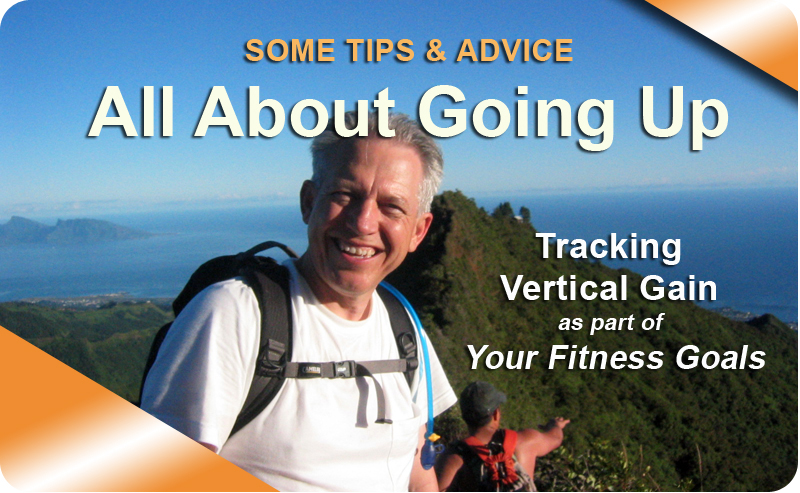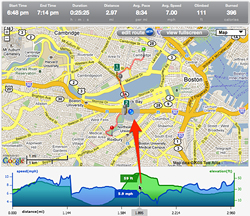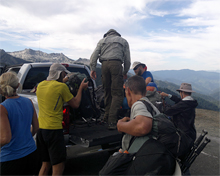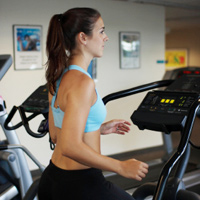

Why vertical?
Walking up an incline makes you breathe harder, upping your heart rate and engaging your circulatory system. Not only do you burn more calories when walking uphill, you tone and strengthen additional muscle groups.
For example, if you weight 160 pounds, walking for one hour on a flat surface burns roughly 200 calories.
By contrast, climbing stairs, a steep hill in your neighborhood, or mountain trail burns far more calories. In an hour you would burn up to 440 calories. This is more than double the calories burned in the same amount of time. So it's also a timesaver.
For every 1% increase in the incline (grade), you will exert up to 4% more energy. As your caloric expenditure goes up, you use even more muscle groups, including among others your buttocks, inner and outer thigh muscles, and your hip flexors. These are some of the largest muscles in the body. Over time, these areas becomes more toned and tightened.
Elevation gain is fairly easy to measure and is typically a good indicator of how much you are exerting, rather than distance alone. Although distance can affect how much you exert as you gain elevation, vertical elevation gain is still an excellent and simple way to monitor your fitness goals.
It's a good practice to incorporate vertical elevation gain as a part of cross-training for all sports, athletic disciplines, and personal fitness programs.
If you regularly log vertical elevation gain, you are accomplishing something important for your body!


Tip: Vertical elevation gain is highly recommended as a cross-training activity for all competitive sports, personal fitness programs, and other athletic disciplines.
Hey! You don't have to climb a mountain!
Every bit helps, even if it's just a flight of stairs.
Special Team Log | Post a Photo | Become a Sports Product Tester
 Who can
benefit from tracking vertical gain? Virtually everyone
can benefit both physically and emotionally from a good fitness workout. But
vertical gain is particularly helpful because of how it works the body. When
you start, remember that walking up an incline is harder than walking on a flat surface.
If you have any health risks or are badly out of shape, you
would be wise to consult your doctor before starting a program. When you start, don't overdo it. If
you're not used to walking uphill, begin slowly.
Who can
benefit from tracking vertical gain? Virtually everyone
can benefit both physically and emotionally from a good fitness workout. But
vertical gain is particularly helpful because of how it works the body. When
you start, remember that walking up an incline is harder than walking on a flat surface.
If you have any health risks or are badly out of shape, you
would be wise to consult your doctor before starting a program. When you start, don't overdo it. If
you're not used to walking uphill, begin slowly.
What is vertical elevation gain and how is it measured? Vertical elevation gain (VEG) is a measurement straight up. It is calculated from a starting elevation to a higher elevation. Vertical means perpendicular to the earth's surface, that is, at 90 degrees. For example, let's suppose you walk 500 feet along a winding trail leading to the top of a hill that is 100 feet high (measured vertically). Your vertical elevation gain is 100 feet, not 500 feet. 500 feet represents the distance you have walked, while 100 feet represents the vertical gain.

Which places are good for my vertical exercise activity? You can log some vertical feet virtually anywhere you can walk up an inclined surface. This could be stairs (such as at home, in an office building, or a sports stadium), hilly streets, or trails on a mountain. Most cities have numerous areas that offer good choices, with a mix of steps, inclined walkways, and multi-story buildings. Use your imagination and keep your eyes open for good spots near your home or work. The more convenient it is, the more often you'll go which is good!
How exactly do I figure the number of vertical feet? Using today's technology, it's quite simple. All you need is a GPS-enabled device, such as a smart phone or GPS watch, that tracks elevation. It'll do all the work for you. (GPS = global positioning system.)
 There are a number of
excellent
apps for both iPhone and android that track elevation automatically. One of
the most popular is
Map My Run
(a free account also lets you use
Map My Walk and
Map My Hike). These apps are
quite easy to use and allow you to view your activity on your mobile device
and computer. Since most people already
have phones, it's a logical solution if you don't need anything more
advanced than tracking your time, distance, and elevation. Plus, these apps
are free.
There are a number of
excellent
apps for both iPhone and android that track elevation automatically. One of
the most popular is
Map My Run
(a free account also lets you use
Map My Walk and
Map My Hike). These apps are
quite easy to use and allow you to view your activity on your mobile device
and computer. Since most people already
have phones, it's a logical solution if you don't need anything more
advanced than tracking your time, distance, and elevation. Plus, these apps
are free.
Personally, I like to climb hands-free without having to dig for my phone to check stats. So I use a GPS watch (I have a Garmin 405CX and a 910XT). A watch tracks elevation by satellite or barometric altimeter. If you're serious about fitness, you may want to consider investing in a good GPS watch. They not only provide a lot of detail about your activity (over 50 metrics to choose from), they're light, easy to carry, and waterproof. However, there is a bit of a learning curve with some of the more advanced models. Several companies make sport watches. Before you buy, check online reviews and user manuals to compare features and prices. Be sure to choose a watch that is GPS-enabled that tracks elevation (not just time and distance).
Short of having an electronic device, you can look up elevations and do calculations manually. For instance, a website called Daft Logic allows you to zoom in on a Google map and click on any spot to get the elevation. You can use this to get the beginning and ending elevation. Then you can simply subtract the lower elevation from the higher elevation. The difference is your vertical elevation gain (assuming you are going uphill!). For example, if you start walking at an elevation of 4,500 feet, and the highest point you reach during your activity is 5,200 feet, you would have a vertical elevation gain of 700 feet. That's easy. But this can sometimes be a little iffy, because if doesn't take into account the "ups" and "downs" along your route. You can figure this out if you are familiar with the exact locations of the high and low points on the map.
If you're climbing stairs and want to keep things really simple (the old-school method), just measure the height (rise) of one stair, then count how many stairs make up one floor (a flight). Using some simple arithmetic, figuring twelve inches per foot, you can quickly determine the number of feet. Then, multiply the number of feet in one flight by the number of floors you climb.
Does it count when I go downhill? Even though you're still getting some physical benefit from going downhill, you should focus on elevation gain, not loss. For example, if you climb a hill that is 100 vertical feet high, and then come back down, that does NOT make 200 feet. Normally, you count only the 100-foot vertical gain of your uphill activity. Remember however, uphill gain can occur several times during the same activity. For instance, suppose you gain 100 vertical feet going up a hill, walk down 50 feet on the other side, and then climb up a taller second hill for another 75 vertical feet. That would give you a total of 175 vertical feet. Whenever you have an elevation loss between gains, you need to remember to add the separate gains together. A GPS device does this for you automatically.
 Do I
always have to walk? What if I ride part way up?
To count your vertical gain, you should walk, run, or climb under your
own power. It doesn't count if you're conveyed or assisted mechanically in
any way. The only exception to this are bicycles and self-powered conveyances
for the physically challenged (such as a non-motorized wheelchair). It
should be obvious that going up by way of ATV, motorbike, ski lift, tram, or
horse doesn't count as
exercise. Of course you can take a car, bus, train, or anything
you want, to get to your starting elevation. After that though, it's
up to your body to make the grade.
Do I
always have to walk? What if I ride part way up?
To count your vertical gain, you should walk, run, or climb under your
own power. It doesn't count if you're conveyed or assisted mechanically in
any way. The only exception to this are bicycles and self-powered conveyances
for the physically challenged (such as a non-motorized wheelchair). It
should be obvious that going up by way of ATV, motorbike, ski lift, tram, or
horse doesn't count as
exercise. Of course you can take a car, bus, train, or anything
you want, to get to your starting elevation. After that though, it's
up to your body to make the grade.
Can I do my activity with other people? By all means. In fact, logging vertical feet with others can be fun and provide extra motivation. If you have friends who are logging vertical feet, you can consider setting up a "team" log to keep track of your combined gain (for example, see my team log). It's fun to work together towards a goal. Having a team log means that you still connect even when you're participating in separate activities. It's great.

(a) Because the machine gives way as you step (sinks or moves down), you might use much less exertion compared to doing the same motion on a solid surface. As you place your weight on the step or pedal, it sinks toward the floor. This means you are not actually lifting your entire body weight in the same way you would if you were stepping up the same distance onto a surface that doesn't move. Depending on how the machine is designed, one leg may also be mechanically assisting the other leg. In some cases, as with elliptical trainers, the mechanical momentum of the machine itself greatly reduces the required exertion. These types of machines can still give you a good workout, but you should plan to work harder and longer for the same results. They can also get a little boring sometimes.
(b) Due to the motion of these machines, it can be difficult to calculate vertical elevation gain. Even though some machines have electronic counters, due to the continuous fluctuation and how it affects exertion, the figures aren't likely to give a true representation of your vertical gain, as compared to walking on a fixed surface. Still, if you can figure it out, you can submit your gain as part of the program.
 Why is
logging vertical gain such a good
fitness choice? Any kind of physical exercise is good for
you and is always better than doing nothing. However, walking,
hiking, cycling, or running with the goal of gaining vertical
elevation has some added advantages that are worth considering
Why is
logging vertical gain such a good
fitness choice? Any kind of physical exercise is good for
you and is always better than doing nothing. However, walking,
hiking, cycling, or running with the goal of gaining vertical
elevation has some added advantages that are worth considering
(a) It's easy to learn. If you know how to walk, you're pretty much there. There are no special skills to master. Pretty much anyone of any age can begin immediately. This means you can also do it with other people, any time, which can make it more fun.
(b) It's low-impact and safe. Unless you've worked your way up to rugged mountain terrain, walking an incline isn't going to jar your frame or expose you to any serious risk of physical harm. A grassy hill at the park just doesn't pose that big of a threat. Of course, if there's any question about your physical condition, you should consult your doctor before beginning an exercise program.
 (c)
You don't need any special equipment. A comfortable pair of shoes is
about all you require. There's no uniform or dress code you can go as
casual or fancy as you want. If you're outdoors in sunny weather, you'll
want a hat and some sun screen. For longer hikes, it's good to take along water and
perhaps a snack (such as a Morinda FIT bar!). But that's about it.
(c)
You don't need any special equipment. A comfortable pair of shoes is
about all you require. There's no uniform or dress code you can go as
casual or fancy as you want. If you're outdoors in sunny weather, you'll
want a hat and some sun screen. For longer hikes, it's good to take along water and
perhaps a snack (such as a Morinda FIT bar!). But that's about it.
(d) It's efficient and fast. You get up to twice the physical benefit during the same amount of time. Climbing uphill is a concentrated way to burn calories, improve your cardiovascular system, and tone your muscles. For every 1% increase in grade, you'll get a 4% increase in exertion. For example, if you hike a 20% grade, you'll use 80% more energy than walking on a flat surface.
(e) It's great personal therapy. Studies have shown that physical activity causes the release of certain natural chemicals (endorphins) that help you feel better. If you get stressed or depressed, go out and gain a few vertical feet. You may be a little tired afterwards, but you'll still feel much better. (By the way, for those times when you can't break away, try one of my 2-minute "hiker's therapy" videos on YouTube: druwhite1.)
 Do you have any helpful tips? As an activity, pursuing vertical elevation is fairly straightforward.
You just go up! However, you may wish to consider some of the following as
you climb to your goals:
Do you have any helpful tips? As an activity, pursuing vertical elevation is fairly straightforward.
You just go up! However, you may wish to consider some of the following as
you climb to your goals:
(a) Wear the right shoes. As mentioned, comfortable footwear is key to having a good experience. Make sure the shoe holds your foot firmly but has plenty of extra space for your toes (so they don't get scrunched coming downhill). A good "grippy" tread is a must for steep trails and boulder hopping. Socks also play a major role, so you should get the best available. My personal preference is Thorlo brand. They're a little pricy, but they're incredible socks.
(b) Pay attention to your breathing. Begin deep breathing immediately when you start to exert. Don't wait until you're oxygen deprived. Try to develop the habit of inhaling deeply through the nostrils and exhaling hard through the mouth. Part of the trick is to expel as much of the "bad air" as possible when you exhale. Shallow breathing just won't cut it. The tiny air sacs inside the lungs (aveoli) are like micro balloons. If you don't keep them stretched out by breathing deeply enough, they can "shrivel" and lose their elasticity. Regular aerobic exercise helps increase their capacity and keeps them healthy.
Because we're doing it all the time, many people don't realize that it takes muscles to breathe. Regular deep breathing helps strengthen those muscles in the chest, back, and diaphragm. Adding some upper-body strength training is a great idea. Exercising with dumbbells two to three times a week to strengthen your arms, shoulders, chest, abs, and back, can greatly enhance your ability to breathe. And you'll look better, too!
 (c)
On steeper surfaces, take shorter steps. A long stride requires much more
exertion to raise your body weight. This can tire you too quickly, and you
may be forced to cut short your activity (which will deprive you of the
maximum benefit you want to get in at least twenty minutes of hard
breathing). On very steep terrain, when you step up you may want to straighten out your leg all the way,
even hyper-extending it a bit. This gives the muscles a split
second to rest. Over thousands of steps, these minute reprieves add up and can be a great help in sustaining
your pace.
(c)
On steeper surfaces, take shorter steps. A long stride requires much more
exertion to raise your body weight. This can tire you too quickly, and you
may be forced to cut short your activity (which will deprive you of the
maximum benefit you want to get in at least twenty minutes of hard
breathing). On very steep terrain, when you step up you may want to straighten out your leg all the way,
even hyper-extending it a bit. This gives the muscles a split
second to rest. Over thousands of steps, these minute reprieves add up and can be a great help in sustaining
your pace.
(d) Take along only what you need. I consider myself to be a "minimalist." When it comes to water, food, equipment, clothing, etc., I take the very least I can get by with, paying particular attention to weight. On longer hikes over steep terrain, every ounce makes a difference. Some people tend to bring a lot of cumbersome items for fear they might need them. This is okay, but unless you're way out there, far from civilization, there's really no need to unnecessarily load yourself down. If you start playing the "what if" game, you can rationalize taking along just about anything. ("Hey, what if we get lost and have to build a shelter? Yeah, better take along a double-bladed axe so we can cut down trees...") You should keep your activity as light and pleasant as possible. Take only what you're truly likely to use. This will greatly increase the chances that you'll repeat it often.
(e) Pay attention to your heart rate. If you don't already know your target heart rate (THR), you need to figure it out. Your THR is based partly on your age and your resting heart rate. Once you've determined your target heart rate, you can use a watch or a wireless heart rate monitor to check your pulse periodically during your activity. This is important, because if your heart rate is too low, you won't get the ideal physical benefit from your workout. On the other hand, if your heart rate is too high, you'll tire too quickly and be forced to cut short your workout, thus rendering your workout much less effective than it could be. Once you are in good shape, your target heart rate can be maintained just below your anaerobic (lactate) threshold.
 (f)
Watch what you eat. No amount of exercise can ever overcome
bad eating habits. It's a
simple matter of arithmetic. You can consume calories far faster than you
can burn them. (Luckily our bodies are designed this way otherwise we
would have to eat every minute of the day to stay alive!) As a general rule
of thumb, an average-size person will burn about 8-10 calories a minute
during a strenuous workout. This means it takes approximately ten
minutes to burn 100 calories. By contrast, you can eat 100 calories in a few
seconds. Fortunately, the body is burning some calories all the time, so we
don't have to rely solely on our exercise time to do the job. But we must
remember that our eating habits have about four times more impact on weight
management than exercise does. Still, exercise is
extremely important for reasons beyond just burning calories. It provides
many vital benefits, including its effect on
metabolism, the immune system, muscle tone, circulation, and emotional
well-being, to name a few.
(f)
Watch what you eat. No amount of exercise can ever overcome
bad eating habits. It's a
simple matter of arithmetic. You can consume calories far faster than you
can burn them. (Luckily our bodies are designed this way otherwise we
would have to eat every minute of the day to stay alive!) As a general rule
of thumb, an average-size person will burn about 8-10 calories a minute
during a strenuous workout. This means it takes approximately ten
minutes to burn 100 calories. By contrast, you can eat 100 calories in a few
seconds. Fortunately, the body is burning some calories all the time, so we
don't have to rely solely on our exercise time to do the job. But we must
remember that our eating habits have about four times more impact on weight
management than exercise does. Still, exercise is
extremely important for reasons beyond just burning calories. It provides
many vital benefits, including its effect on
metabolism, the immune system, muscle tone, circulation, and emotional
well-being, to name a few.
New research shows that not all calories are created equal. In other words, the same number of calories from two different kinds of food may have a drastically different effect on the body. Consuming 200 calories of vegetables isn't the same as eating 200 calories of candy. Scientists now believe that added sugars are a major contributor to health problems, including conditions such as obesity, diabetes, and metabolic syndrome. According to some researchers, fructose appears to be particularly problematic when it's processed or used as an additive.
 (g)
Drink MAX every day. Ideally you should take at least two ounces
(about four tablespoons) of MAX every day. If you take more, it certainly
won't hurt. Research indicates that MAX promotes healthy angiogenesis. When
the circulatory system is working properly, better health
naturally follows: stronger immune system, greater mobility, stronger bones and joints,
improved mental alertness, and superior oxygen uptake for increased stamina, more energy, and quicker recovery.
(g)
Drink MAX every day. Ideally you should take at least two ounces
(about four tablespoons) of MAX every day. If you take more, it certainly
won't hurt. Research indicates that MAX promotes healthy angiogenesis. When
the circulatory system is working properly, better health
naturally follows: stronger immune system, greater mobility, stronger bones and joints,
improved mental alertness, and superior oxygen uptake for increased stamina, more energy, and quicker recovery.
It's important to take MAX every day, at least once every twenty-four hours. (This is due to the molecular half-life of iridoid compounds.) Many people take it twice a day, once in the morning and once in the evening. Personally, I take it just once a day in the morning. But I never miss!
You really should think seriously about becoming a sports product tester.
Home Guide Featured FAQ Join Us Test Log Group Log Terms of Use & Privacy Contact
ฉ 2012-17 Coconut Enterprises, LLC. All rights reserved.
Independent Product Consultant for Morinda, Inc.
Coconut Groupฎ International is a registered trademark of Coconut Enterprises, LLC.